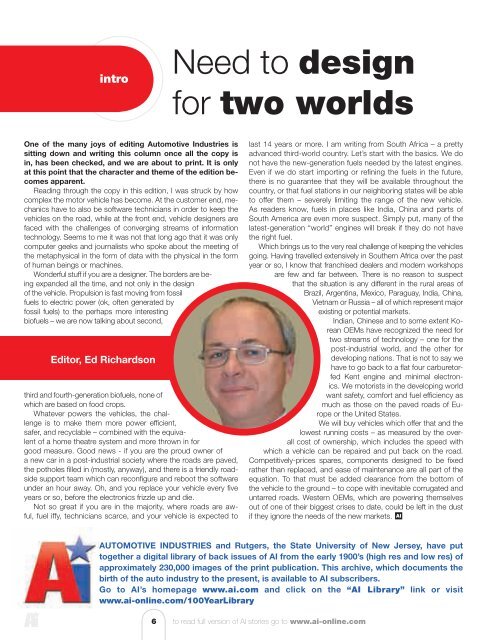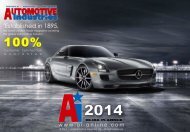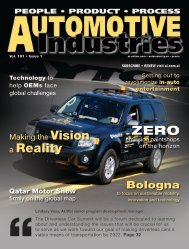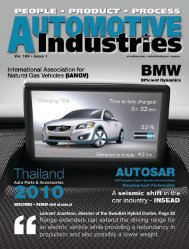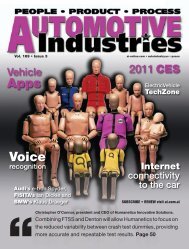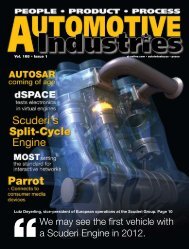engineering, AUTOSAR - Automotive Industries
engineering, AUTOSAR - Automotive Industries
engineering, AUTOSAR - Automotive Industries
You also want an ePaper? Increase the reach of your titles
YUMPU automatically turns print PDFs into web optimized ePapers that Google loves.
intro<br />
One of the many joys of editing <strong>Automotive</strong> <strong>Industries</strong> is<br />
sitting down and writing this column once all the copy is<br />
in, has been checked, and we are about to print. It is only<br />
at this point that the character and theme of the edition becomes<br />
apparent.<br />
Reading through the copy in this edition, I was struck by how<br />
complex the motor vehicle has become. At the customer end, mechanics<br />
have to also be software technicians in order to keep the<br />
vehicles on the road, while at the front end, vehicle designers are<br />
faced with the challenges of converging streams of information<br />
technology. Seems to me it was not that long ago that it was only<br />
computer geeks and journalists who spoke about the meeting of<br />
the metaphysical in the form of data with the physical in the form<br />
of human beings or machines.<br />
Wonderful stuff if you are a designer. The borders are being<br />
expanded all the time, and not only in the design<br />
of the vehicle. Propulsion is fast moving from fossil<br />
fuels to electric power (ok, often generated by<br />
fossil fuels) to the perhaps more interesting<br />
biofuels – we are now talking about second,<br />
Editor, Ed Richardson<br />
third and fourth-generation biofuels, none of<br />
which are based on food crops.<br />
Whatever powers the vehicles, the challenge<br />
is to make them more power efficient,<br />
safer, and recyclable – combined with the equivalent<br />
of a home theatre system and more thrown in for<br />
good measure. Good news - if you are the proud owner of<br />
a new car in a post-industrial society where the roads are paved,<br />
the potholes filled in (mostly, anyway), and there is a friendly roadside<br />
support team which can reconfigure and reboot the software<br />
under an hour away. Oh, and you replace your vehicle every five<br />
years or so, before the electronics frizzle up and die.<br />
Not so great if you are in the majority, where roads are awful,<br />
fuel iffy, technicians scarce, and your vehicle is expected to<br />
Need to design<br />
for two worlds<br />
last 14 years or more. I am writing from South Africa – a pretty<br />
advanced third-world country. Let’s start with the basics. We do<br />
not have the new-generation fuels needed by the latest engines.<br />
Even if we do start importing or refining the fuels in the future,<br />
there is no guarantee that they will be available throughout the<br />
country, or that fuel stations in our neighboring states will be able<br />
to offer them – severely limiting the range of the new vehicle.<br />
As readers know, fuels in places like India, China and parts of<br />
South America are even more suspect. Simply put, many of the<br />
latest-generation “world” engines will break if they do not have<br />
the right fuel.<br />
Which brings us to the very real challenge of keeping the vehicles<br />
going. Having travelled extensively in Southern Africa over the past<br />
year or so, I know that franchised dealers and modern workshops<br />
are few and far between. There is no reason to suspect<br />
that the situation is any different in the rural areas of<br />
Brazil, Argentina, Mexico, Paraguay, India, China,<br />
Vietnam or Russia – all of which represent major<br />
existing or potential markets.<br />
Indian, Chinese and to some extent Korean<br />
OEMs have recognized the need for<br />
two streams of technology – one for the<br />
post-industrial world, and the other for<br />
developing nations. That is not to say we<br />
have to go back to a flat four carburetorfed<br />
Kent engine and minimal electronics.<br />
We motorists in the developing world<br />
want safety, comfort and fuel efficiency as<br />
much as those on the paved roads of Europe<br />
or the United States.<br />
We will buy vehicles which offer that and the<br />
lowest running costs – as measured by the overall<br />
cost of ownership, which includes the speed with<br />
which a vehicle can be repaired and put back on the road.<br />
Competitively-prices spares, components designed to be fixed<br />
rather than replaced, and ease of maintenance are all part of the<br />
equation. To that must be added clearance from the bottom of<br />
the vehicle to the ground – to cope with inevitable corrugated and<br />
untarred roads. Western OEMs, which are powering themselves<br />
out of one of their biggest crises to date, could be left in the dust<br />
if they ignore the needs of the new markets. AI<br />
AUTOMOTIVE INDUSTRIES and Rutgers, the State University of New Jersey, have put<br />
together a digital library of back issues of AI from the early 1900’s (high res and low res) of<br />
approximately 230,000 images of the print publication. This archive, which documents the<br />
birth of the auto industry to the present, is available to AI subscribers.<br />
Go to AI’s homepage www.ai.com and click on the “AI Library” link or visit<br />
www.ai-online.com/100YearLibrary<br />
6 to read full version of AI stories go to www.ai-online.com


